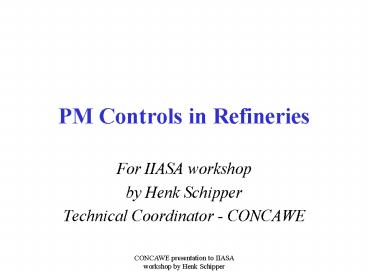PM Controls in Refineries - PowerPoint PPT Presentation
1 / 8
Title: PM Controls in Refineries
1
PM Controls in Refineries
- For IIASA workshop
- by Henk Schipper
- Technical Coordinator - CONCAWE
2
Sources of particulates in refineries
- Oil fired equipment
- process heaters
- boilers (burning oil)
- Fluids Catalytic Cracking Unit (FCCU)
- catalyst regenerators of such units
3
PM from Oil fired Equipment
- Types of PM in flue gases
- soot, the particle size is below 1 µm visible
smoke from a stack is caused by all particles but
mainly 0.5 to 5 µm - cenospheres they originate from the liquid
phase residues of combustion of heavy oil
droplets, at relatively low temperature (lt 700
C), the size is equal to or larger than that of
the original oil droplets - coke particles, formed through liquid phase
cracking in combustion at high temperatures (gt
700 C). The particle size is generally from 1 to
10 µm. - fine particles (lt 0,01 µm) their contribution to
the total mass emission is negligible.
4
Catalyst Regeneration
- Coke deposited on catalyst is passed through a
regenerator, where it is burned off. The
combustion gasses are passed through cyclones
before disposal to the stack. About 90 is lt 10
mm. The main control for PM emissions is correct
operating conditions! Basic design includes 2
stage cyclones - Further improvements by (very site specific)
- tertiary cyclones
- multi cyclones
- electrostatic precipitators
- wet flue gas scrubbers
5
Coking Plants
- Coking as described here is a severe thermal
cracking process that maximises the severity to
the extent that coke is formed while production
of the more profitable light products is
maximised - Unburnt gases from the calciner are burned in an
incinerator, then passed through a waste heat
boiler before being released to the atmosphere
via a dust collection system - PM emissions from
- furnace flue gas
- coke fines (particulates) from handling of coke
- the calciner.
- Controls same as for Cat Cracker. In addition bag
filters can be used for handling of coke fines at
a Capex of about 5 M EUR.
6
Process Fired Heaters
7
BOILERS
8
Cat Cracker Coker































